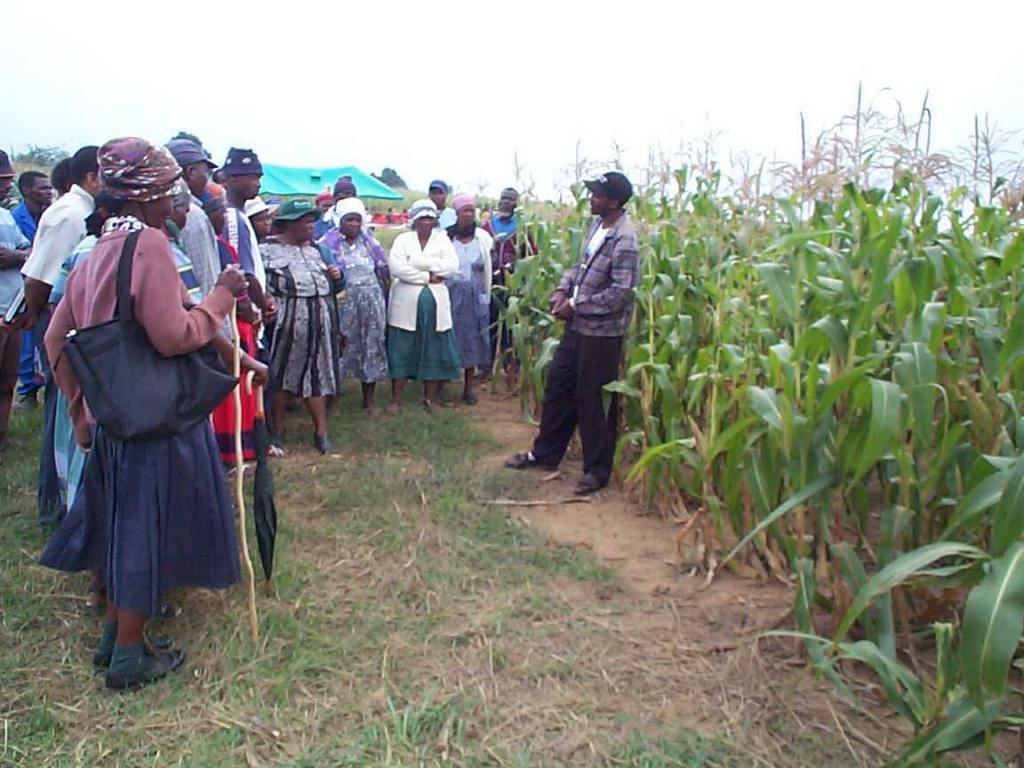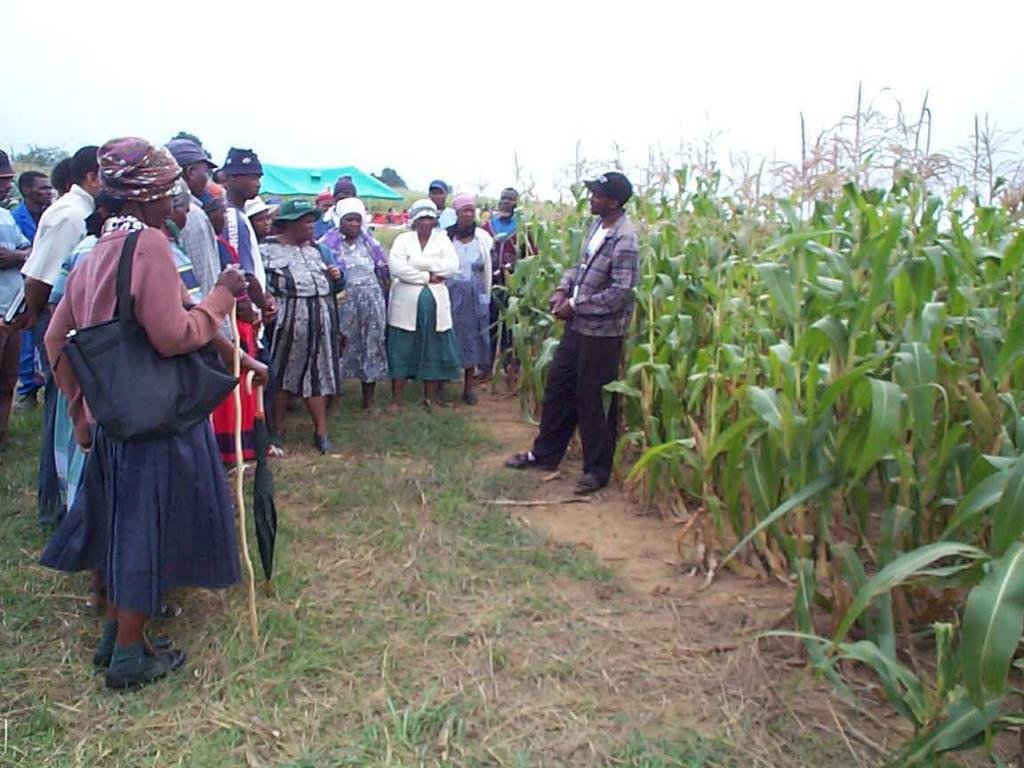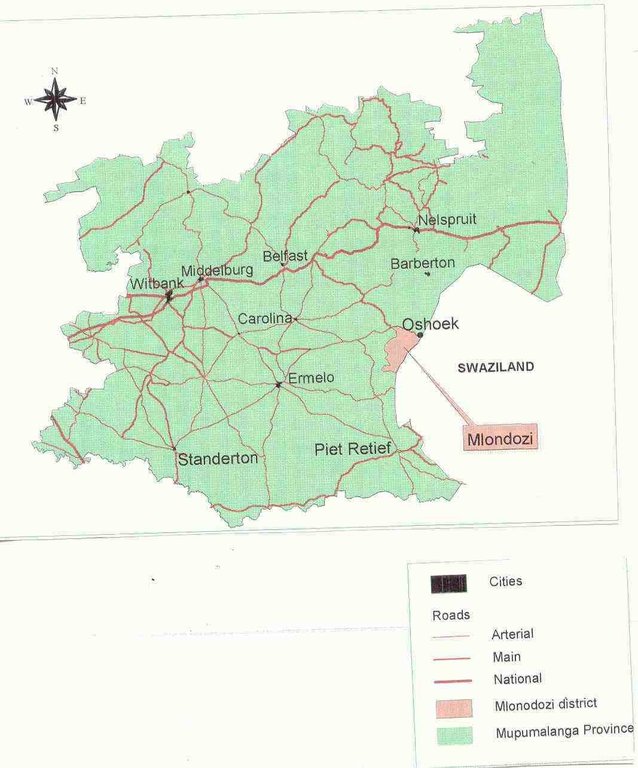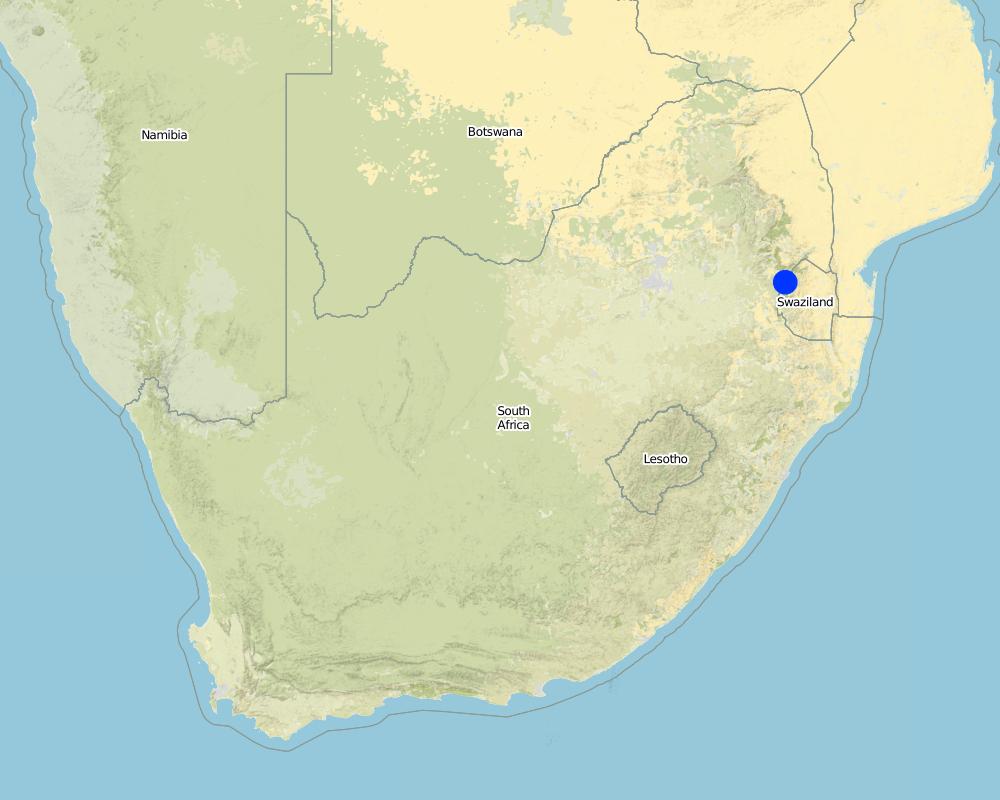Farmers involved in own development [South Africa]
- Creation:
- Update:
- Compiler: Hester Gertruida Jansen van Rensburg
- Editor: –
- Reviewer: Fabian Ottiger
approaches_2337 - South Africa
View sections
Expand all Collapse all1. General information
1.2 Contact details of resource persons and institutions involved in the assessment and documentation of the Approach
Name of the institution(s) which facilitated the documentation/ evaluation of the Approach (if relevant)
Agricultural Research Council (ARC) - South Africa1.3 Conditions regarding the use of data documented through WOCAT
The compiler and key resource person(s) accept the conditions regarding the use of data documented through WOCAT:
Yes
1.4 Reference(s) to Questionnaire(s) on SLM Technologies
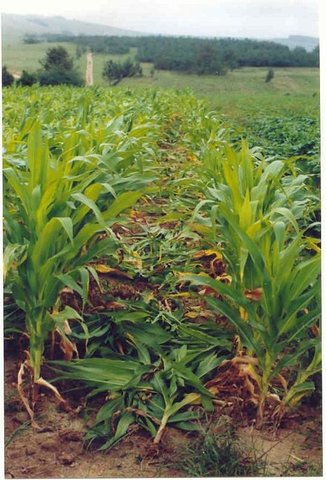
Conservation Agriculture [South Africa]
Conservation agriculture included aspects such as crop rotation, mulching and no-tillage.
- Compiler: Hester Gertruida Jansen van Rensburg
2. Description of the SLM Approach
2.1 Short description of the Approach
Planting without ploughing in a crop rotation system to improve moisture management, reduce erosion and increase crop yield.
2.2 Detailed description of the Approach
Detailed description of the Approach:
Aims / objectives: Farmers deal with major problems such as shortages and bad implements, soil erosion and high input costs. The purpose of the project is to involve farmers in their own development, by demonstrating and training in Conservation Agriculture technologies. The methods of doing this include on-farm demonstrations (farm-led) and training courses (discovery-learning courses). The project is in the final stage; the exit plan is already implemented. The participants are both land owners and managers of the project.
2.3 Photos of the Approach
2.5 Country/ region/ locations where the Approach has been applied
Country:
South Africa
Region/ State/ Province:
Mpumalanga
Map
×2.6 Dates of initiation and termination of the Approach
Year of termination (if Approach is no longer applied):
2002
2.7 Type of Approach
- project/ programme based
2.8 Main aims/ objectives of the Approach
The Approach focused mainly on SLM with other activities
To empower community to take ownership of the projects. To train community in sustainable utilisation of their Natural Resources. To improve food security.
The SLM Approach addressed the following problems: Physical and chemical degraded land. Changing of attitudes and getting community to take ownership of project.
2.9 Conditions enabling or hindering implementation of the Technology/ Technologies applied under the Approach
availability/ access to financial resources and services
- hindering
Agriculture - high input cost with low return
Treatment through the SLM Approach: Reduce input cost
legal framework (land tenure, land and water use rights)
- enabling
The existing land ownership, land use rights / water rights moderately helped the approach implementation: hinder: moderate
- hindering
No land tenure
Treatment through the SLM Approach:
knowledge about SLM, access to technical support
- hindering
Lack of knowledge on improve agriculture technology
Treatment through the SLM Approach: Training
3. Participation and roles of stakeholders involved
3.1 Stakeholders involved in the Approach and their roles
- local land users/ local communities
Mlondozi Community
Working land users were work equally divided between men and women (Men - 60% Women - 40%). Socially disadvantaged included by the Agriculture Development Committee in consultation with farmer groups.
- NGO
Agriculture Research Council - Institute for Soil, Climate & Water
- national government (planners, decision-makers)
Mpumalanga Department of Agriculture, Environment & Conservation
3.2 Involvement of local land users/ local communities in the different phases of the Approach
| Involvement of local land users/ local communities | Specify who was involved and describe activities | |
|---|---|---|
| initiation/ motivation | external support | Mainly:interviews/questionnaires; partly: rapid/participatory rural appraisal |
| planning | interactive | Mainly: public meetings; partly: workshops/seminars |
| implementation | self-mobilization | responsibility for major steps; Study groups/Training/Farm-led demo's |
| monitoring/ evaluation | interactive | Mainly: interviews/questionnaires; partly: reporting; |
| Research | passive | on-farm; On-farm research - technologies implemented on-farm by farmer-led demo's. |
3.4 Decision-making on the selection of SLM Technology/ Technologies
Specify who decided on the selection of the Technology/ Technologies to be implemented:
- mainly land users, supported by SLM specialists
Explain:
land user driven (bottom-up).
Decisions on the method of implementing the SLM Technology were made by mainly by land users supported by SLM specialists. land user driven (bottom-up).
4. Technical support, capacity building, and knowledge management
4.1 Capacity building/ training
Was training provided to land users/ other stakeholders?
Yes
Specify who was trained:
- land users
- SWC specialists, extensionists/trainers
Form of training:
- farmer-to-farmer
- demonstration areas
- public meetings
- courses
Subjects covered:
Farm planning/Soil fertility/Management/Post management/No-tillage management/etc.
4.2 Advisory service
Do land users have access to an advisory service?
Yes
Specify whether advisory service is provided:
- on land users' fields
- at permanent centres
- Meetings and courses
Describe/ comments:
Name of method used for advisory service: Farming Systems Research & Extension; Key elements: Training, Demonstrations, Participation; 1) Mainly: government's existing extension system, Partly: non-governmental agency. Extension staff: mainly government employees 3) Target groups for extension: land users; Activities: Farmer groups/On-farm - Farmer-led demonstrations
Advisory service is very adequate to ensure the continuation of land conservation activities; Very well understanding of SWC technology.
4.3 Institution strengthening (organizational development)
Have institutions been established or strengthened through the Approach?
- yes, greatly
Specify the level(s) at which institutions have been strengthened or established:
- local
Specify type of support:
- capacity building/ training
4.4 Monitoring and evaluation
Is monitoring and evaluation part of the Approach?
Yes
Comments:
bio-physical aspects were regular monitored through observations
socio-cultural aspects were regular monitored through observations
economic / production aspects were regular monitored through measurements
no. of land users involved aspects were regular monitored through measurements
management of Approach aspects were regular monitored through measurements
There were few changes in the Approach as a result of monitoring and evaluation: Had to focus more on participatory training.
4.5 Research
Was research part of the Approach?
Yes
Specify topics:
- technology
Give further details and indicate who did the research:
Fertiliser calibration trails/Cultivar (different crops) trails, etc.
Research was carried out on-farm
5. Financing and external material support
5.1 Annual budget for the SLM component of the Approach
If precise annual budget is not known, indicate range:
- 100,000-1,000,000
Comments (e.g. main sources of funding/ major donors):
Approach costs were met by the following donors: government (national - NDA): 90.0%; international non-government (-): 10.0%
5.2 Financial/ material support provided to land users
Did land users receive financial/ material support for implementing the Technology/ Technologies?
Yes
5.3 Subsidies for specific inputs (including labour)
- agricultural
| Specify which inputs were subsidised | To which extent | Specify subsidies |
|---|---|---|
| seeds | partly financed | |
| fertilizers | partly financed | |
If labour by land users was a substantial input, was it:
- voluntary
5.4 Credit
Was credit provided under the Approach for SLM activities?
No
6. Impact analysis and concluding statements
6.1 Impacts of the Approach
Did the Approach help land users to implement and maintain SLM Technologies?
- No
- Yes, little
- Yes, moderately
- Yes, greatly
Conservation Agriculture technology - new technologies (mulch, no-tillage, crop rotation).
Did the Approach improve issues of land tenure/ user rights that hindered implementation of SLM Technologies?
- No
- Yes, little
- Yes, moderately
- Yes, greatly
The problem is likely to be overcome in the near future. Farmers applied for land tenure.
Did other land users / projects adopt the Approach?
- No
- Yes, little
- Yes, moderately
- Yes, greatly
Lusikisiki LandCare Project, Bergville LandCare Project, Bizane LandCare Project
6.3 Sustainability of Approach activities
Can the land users sustain what has been implemented through the Approach (without external support)?
- yes
6.4 Strengths/ advantages of the Approach
| Strengths/ advantages/ opportunities in the land user’s view |
|---|
| Like new way of training (How to sustain/ enhance this strength: Learning-by-doing courses) |
| Increase income |
| Strengths/ advantages/ opportunities in the compiler’s or other key resource person’s view |
|---|
| Ownership of project (How to sustain/ enhance this strength: Follow-up meetings and training) |
| On-farm |
| Extension services (How to sustain/ enhance this strength: On-going support) |
6.5 Weaknesses/ disadvantages of the Approach and ways of overcoming them
| Weaknesses/ disadvantages/ risks in the compiler’s or other key resource person’s view | How can they be overcome? |
|---|---|
| Can only involve a certain amount of farmers every year | Train trainers |
7. References and links
7.1 Methods/ sources of information
- field visits, field surveys
- interviews with land users
7.2 References to available publications
Title, author, year, ISBN:
Demonstration and assessment of sustainable land management practices in the Mlondozi district of Mpumalanga. Du Preez, Kidson, Beukes & Smith, 1998, 1999, 2000.
Available from where? Costs?
ARC - ISCW
Links and modules
Expand all Collapse allLinks

Conservation Agriculture [South Africa]
Conservation agriculture included aspects such as crop rotation, mulching and no-tillage.
- Compiler: Hester Gertruida Jansen van Rensburg
Modules
No modules


